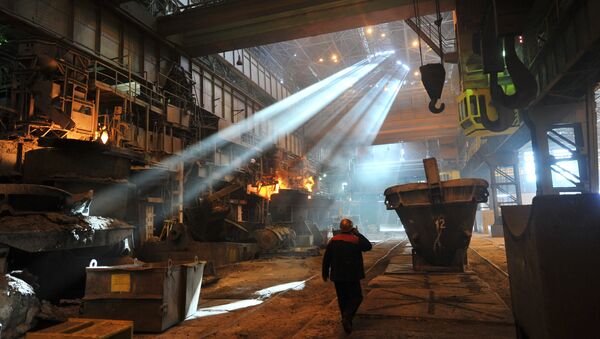Vice-Rector for Science and Innovations of the National University of Science and Technology (MISIS) Mikhail Filonov told RIA Novosti how this leading university is overcoming the resistance of the environment, finding opportunities to build new laboratories, attracting world-class scientists and implementing unique, innovative projects in resource-intensive areas.
Q: Mr. Filonov, MISIS scientists are working in different areas developing innovations. But your university is also dealing with metallurgy, which has been important for it since Soviet times and which requires urgent modernization. Are you managing to achieve anything in this area?
Mikhail Filonov: MISIS has a group of industrial partners – RUSAL, OMK, Nornickel, Severstal, and NLMK – with which we have been cooperating. They regularly give us technical assignments on different projects. Here’s an example of our cooperation. During the past few years the MISIS working group developed technology for the production of high-purity aluminum oxide and received a relevant contract from RUSAL to move forward with this project. RUSAL also concluded contracts with it on 10-15 other projects.
Another project that MISIS successfully commercialized is a high-tech uniform for the Fire Service of the Emergencies Ministry. It can withstand temperatures of up to +800 C. Its heat-resistant fiber can withstand open flames up to +1,200 C, the influence of strong magnetic fields and chemical compounds.
Q: Have you been able to persuade private companies to invest long-term?
Mikhail Filonov: We have developed a unique first trial model of the Vanyukov furnace.
This is an autogenic smelt-furnace for processing non-ferrous metals. Smelting occurs in the slag-matte bath of the furnace where a mixture of oxygen and air is intensively pumped. Its counterpart in ferrous metallurgy is the Romelt furnace. It was also developed by MISIS scientists. As I said, the Romelt furnace was built for processing ferrous metals in Lipetsk in the 1980s.
We carried out this breakthrough project in metallurgy with the funds of a private investor. The new furnace for non-ferrous metals is based on the development of Romelt technology. It works on the bubble principle and has two sections for restoring and oxidizing smelting. These two processes are united into one cycle. Some 200-250 million rubles were invested in this comparatively small two-meter furnace. Its construction from scratch – outside a metallurgical plant – will cost one billion rubles.
Its purpose and competitive advantage lies in processing slags and toxic waste of metallurgical and chemical production. It is possible to use low-grade coal. Its efficiency rate is less than that of a blast furnace but the latter cannot process slags and toxic waste. Now that the world’s only trial model has been created, it is possible to build a bigger furnace to process waste. This is a ticket to the future because all metallurgical plants lack room for storing their waste.
Q: Does NUST MISIS hire not only Russian but also foreign world-class scientists?
Mikhail Filonov: We have both university graduates that are among the most cited in the world and leading scientists who existed in absolute isolation until recently. For example, the President of Japan’s elite Josai University Akihisa Inoue recently headed a laboratory at MISIS. He was the first to discover materials based on bulk metallic glass. His Hirsch index (which quantifies a scientist’s research output) is 116, which is a very high figure for any country.
Q: We know that in Russia the highest Hirsch index belongs to physicist Ruslan Valiyev (h-86) who also works with you. How did you manage to create conditions that draw in such people?
Mikhail Filonov: We have built modern infrastructure. We managed to make it comfortable for them: location in downtown Moscow, a good campus, the equipment with which they are used to working in their universities and an English-speaking environment. For instance, Akihisa Inoue works with metallic glass and magnetically soft materials (which can be magnetized without much energy) with a view to substantially reducing electricity consumption. We have created conditions that allow him to work here for more than four months per year.
Q: How did you manage to provide a competitive salary?
Mikhail Filonov: By using the 5-100 breakthrough federal program. It opened the door to the future for us. You could say it provides for development rather than the consumption of reserves. Unlike other federal programs, it allows us to buy equipment, invite any leading scientist and build new laboratories. In addition, this program allows us to make our own research agenda and tailor it to the global one. It gives us 70 percent of top publications, which makes MISIS look much better against the general background, and our new laboratories are the driving force of all Russian science. We are already included in the top 100 [globally] in metallurgy and mining, and the top 200 in materials science.
Q: Is MISIS developing digital technology?
Mikhail Filonov: We want to become a competence center for state companies and government agencies on introducing blockchain technology in public administration. This is a new project at our university, in cooperation with Vnesheconombank. Our new center has brought together leading world and Russian experts to implement pilot projects on the basis of blockchain technology in different areas of public administration: from the registration of real estate deals to monitoring medicine supply chains. Such international companies as Ethereum, Bitfury, Waves, E&Y, and PwC were our first partners and are currently residents of the center. Now we are developing a number of new projects that will hopefully guarantee Russia an independent and safe future in digital technology.


